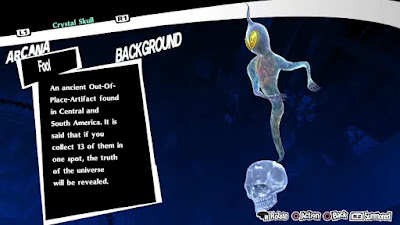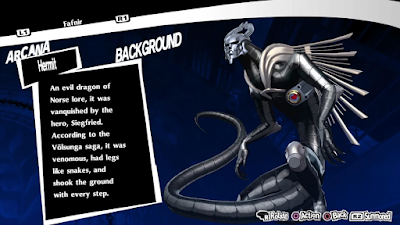
Still enjoying the little twist they did for Royal, which I thought was a much more interesting 'ultimate rebellion' as they rebel against a false reality -- the fact that they're rebelling against a nice, sugary treat in front of them feels so much more awesome than the apathy that Yaldabaoth did. Not to say I didn't enjoy Persona 5's climax, but I really felt like the Royal story with Sumire, Maruki and the rest of the Phantom Thieves -- as cliched as some parts of it are, ends up feeling a fair bit better.
Anyway, I'm trying to rush all of my social stuff first, which is why this 'episode' is going to be filled mostly with fusion Personas and some third-tier ones.
_______________________________________


Célestine
"I'm never going to lose my way again. From now on, I'm going to face reality. For me, for Shiho... and for you."
- Arcana: Lovers
Ann's two Personas, Carmen and Hecate, merge together into Célestine, named after Célestine Galli-Marié, the opera actress that popularized the role of Carmen in opera. Despite originally being a mere third choice, Célestine's performance was so powerful that the composers and show-writers actually changed part of the script and argued with management that the play not be toned down because of Célestine's powerful performance. Persona's Célestine also has a reference to the lyric from the opera, the words "C'est toi? C'est moi?", spoken by Carmen in the climax scene, translating roughly to 'free she was born; free she will die', as Carmen refuses to be bound to any man even at the pain of death.
Célestine's design is... it's all right? I do like that there's a bit more deviation than Raoul or Diego had compared to Arsene and Zorro respectively. There's still the silhouette of Carmen 'punishing' two slaves, though this time those two little gremlins look a bit less lovestruck. Célestine herself has two gigantic tentacle-whip Medusa hair arranged in a giant heart, which... is okay, I guess, but I do find it interesting that the rest of her design is basically a modern-day punk, or a punk rockstar of some sort. That's a rather cool design, though, with the bubblegum and the asymmetry in her jacket sleeves and stockings. Again, while I don't have much to say about these humanoid Personas, I do appreciate the uniqueness and the 'update' on the classic Carmen.


William
"I'll stick with the reality we fought for. The one where we went through all our shit together. That's where I belong."
- Arcana: Chariot
My boy Ryuji's Persona, meanwhile, continues the silhouette that both Captain Kidd and Seiten Taisei has, of a humanoid figure riding a gigantic vehicle like a surfboard. 'William' here is just the first name of Captain William Kidd, so it's pretty simple.
But despite this originally looking like just a modernization of Captain Kidd, it really struck me how this is basically a brand-new design; as different from Kidd as Célestine was from Carmen! Captain Kidd's boat is changed to a gigantic modern (and even futuristic-looking) cruise ship. Kidd's cannon arm is some kind of a railgun, and the general vibe of William has him looking like he could be a punk, hanging out with Célestine in the skateboard park and looking cool. The hoodie, the flowing cloak, the lanky proportions, the gigantic headphones... really, the only thing that marks William as being a Persona instead of a dude is that he still has Captain Kidd's skeleton face!
(William's hoodie has the writing 'Hanged 1701', a morbid but historically accurate joke about how the real-life William Kidd was hanged in the year 1701.)

Surt
- Monster Name: Blazing Giant
- Arcana: Magician
This guy's been visible for a while on my Persona fusion lists, but I just didn't have the level to summon him! Surt is the English translation of Surtr, a figure from Norse mythology. Though thanks to things like Marvel's Thor and God of War, 'Surtr' or 'Surtur' is how the giant seems to be spelled in pop culture nowadays. Surtr is the mightiest fire giant that rules over Muspelheim, the land of fire.
Persona's version of Surtr actually eschews the version that I always tend to see in these adaptations of Norse mythology, of a giant wreathed in fire. Instead, Surt here is a blackened titan with some lava-like markings and a fiery sword instead... which actually fits Surtr's actual name better -- Surtr means 'black' or 'the swarthy one'. Surtr guards Muspelheim with a sword of fire, and 'at the end of the world, he will go and wage war, and defeat all the gods and burn the whole world with fire'.
In Nordic mythology, Surtr's biggest role is at the end of the world, in Ragnarok, where Surtr will finally walk out of Muspelheim alongside other monsters, giants and evil gods to fight against the Aesir -- the gods that guard humanity. Surtr will battle and slay the god Freyr, and the flames that he brings forth would engulf all of Midgard (Earth) and wipe the slate of the world clean for the few survivors of Ragnarok to continue the next cycle.

Futsunushi
- Monster Name: N/A
- Arcana: Magician

Futsunushi-no-Kami is a legendary warrior god, and he is regarded as the ancestor of the Mononobe clan, and is one of the patron teacher-deities of the Fujiwara clan alongside Take-Mikazuchi. As the Persona description notes, the 'futsu' in his name, is the onomatopoeia for a sword swinging and cutting something, while 'nushi' means master. Depending on the version of the myth, Futsunushi was born from the blood spilled when Izanagi killed the fire god Hi-no-Kagutsuchi; some other myths note that Futsunushi is descended from the gods born from this spilled blood. Futsunushi accompanied Takemikazuchi when they went down and demanded the earthly deity Okuninushi (who we covered before) to relinquish his authority. While previous messengers have failed, Takemikazuchi and Futsunushi's arrival did cause Okuninushi to submit, and the two would wipe out any of the other rebelling gods.

Crystal Skull
- Monster Name: N/A
- Arcana: Fool
I thought I talked about this one, but apparently I didn't? Our one last Treasure Demon is the Crystal Skull, which is very infamously the subject of the terrible Indiana Jones movie no one really wants to talk about. The Crystal Skull are a legendary 'OOParts', or out-of-place artifacts, where they show up in places that, archaeologically speaking, they shouldn't be in. This often leads to conspiracies about aliens, the occult, time-travelers or what-have-you.
The Crystal Skulls were allegedly pre-Columbian Mesoamerican artifacts, and there were supposed to be 13 of them. When they are all gathered, they would reveal the mysteries of the universe. It's all utter nonsense, however, because not a single Crystal Skull has ever been found in an archaeological dig, and nowadays it's accepted that the skulls found in the 1800's are likely manufactured in Europe to capitalize and cash in on the boom of artifacts from the New World.

Siegfried
- Monster Name: Dragon-Slaying Genius
- Arcana: Faith
The brave hero Siegfried (originally Sigurd) is the protagonist of the Germanic epic Das Nibelungenlied, which is widely known when Richard Wagner adapted it into a series of operas. Sigurd is also featured in the Prose Edda, one of the most complete remaining sources of Nordic mythology. The stories around Sigurd/Siegfried are numerous, and I do encourage reading up on a summary or a synopsis of the Nibelungenlied epic -- which would go on to inspire things like Lord of the Rings.
One of the most epic things that Sigurd did in these myths is slaying a dragon, Fafnir, with the blade Gram. He would then claim the hoard of the dragon. This story was the inspiration behind many Western stories (including The Hobbit) of a hero going into a dragon's hoard with gigantic piles of gold. Sigurd's foster father, Regin, tasked him to slay Fafnir. On the way to slay the dragon, Sigurd happened to meet the chief god Odin, though he did not know his identity. Odin gave Sigurd some advice, telling him to dig trenches to drain the dragon's blood, which gave him invulnerability. Sigurd would bathe in his blood, and gain hardened skin himself -- though a leaf that fell on his shoulder gave him a weak spot. This blood also told Sigurd that the curse of greed attached to the gold hoard has also corrupted his foster father Regin, who planned to kill him after the fact to keep the gold to himself. Thus, Sigurd was also forced to kill Regin.
Depending on the specific myth, Sigurd's adventures afterwards vary, though there is normally some kind of conflict with the powerful woman (either a valkyrie or a queen) Brynhild/Brunhild. In the Nibelungenlied, conflict arose when Siegfried used an artifact he has, a magical cloak that grants him invisibility, to help his friend Gunther woo the queen Brunhild and help Gunther pass through the trials she puts. In the deception, they claim that Siegfried is Gunther's vassal. However, Brunhild came into conflict against Siegfried's wife Kriemhild. Brunhild accuses Kriemhild of being the wife of a mere vassal, while Kriemhild accuses Brunhild of having her virginity taken by Siegfried (thanks to Siegfried taking Brunhild's belt and ring when he helped Gunther). Brunhild would conspire with Gunther, and another vassal, Hagen, to murder Siegfried. They find out about Siegfried's weakness, and during a hunting party, Siegfried was stabbed by Hagen with a spear.
Anyway, that's mostly the German version of the story, highly condensed and eliminating some characters. Siegfried himself is... he sure is a guy in armour with red skin (from the blood?) and, while it's a bit hard to see, three's a tattoo of a leaf on his shoulder, alluding to his weak spot in the story. Nice!

Fafnir
- Monster Name: Evil Voracious Dragon
- Arcana: Hermit

And... what a cool-ass design. They could've gone with a generic reptilian dragon. They could've gone with a metallic dragon. But no. Fafnir is a humanoid robot with a silhouette that somewhat resembles a dragon, but feels more like some kind of sleek sci-fi robot alien based on the aesthetic of Aliens or something. What a cool design! Look at that very sterile, inhuman-looking face. Look at that creepy skull face, and the halo-like head crest Look at those wings that run down his body like ridges. Look at those kooky, reptile-man hands, and those random sci-fi greebles all over his torso and abdomen. It's such a bizarre take on what's otherwise a 'classic' dragon, and I love it!
This probably works with how Fafnir's description has differed from tellings, and works with how vague 'dragon' or 'wyrm' are. While most artwork of Fafnir tended to draw him like a regular European dragon, man, this Xenomorph-man looks so much cooler as a cursed human than a regular winged reptile would've been! In the Megami Tensei games, Fafnir was just a fat reptile dragon until one game decided to randomly make Fafnir into a robot dragon and that design stuck!
No comments:
Post a Comment